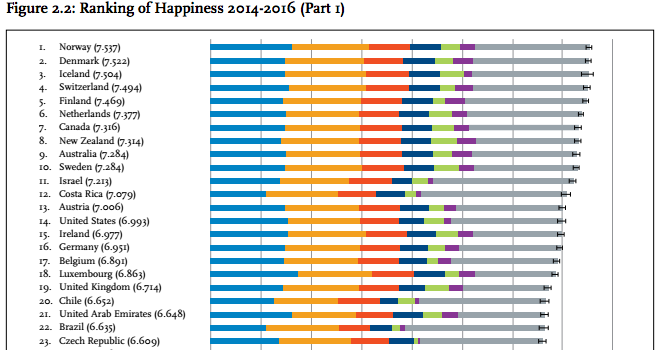Lies Of Omission
March 23, 2017

it’s a lot of responsibility, granted
New York Times, “Norway Is No. 1 in Happiness. The U.S., Sadly, Is No. 14.” Note that the Times is careful to say that they are “sad” about these results. That’s how they show that they are objective.
I.
This nonsense concerns the 2017 World Happiness Report, written by a bunch of PhD golems doing part-time for the United Nations. Let’s go straight to the conclusion.
“The country is mired in a roiling social crisis that is getting worse,” [Dr. Jeffrey Sachs] wrote in [the concluding] chapter dedicated to America’s flagging happiness. “Yet the dominant political discourse is all about raising the rate of economic growth.”
To fix that social fraying, Dr. Sachs argues policy makers should work toward campaign finance reform, reducing income and wealth inequality, improving social relations between native-born and immigrant populations, overcoming the national culture of fear induced by the Sept. 11 attacks, and improving the educational system.
Right away, you should be skeptical. The survey (Gallup World Poll) from which this report draws its conclusions did not ask about September 11. It did not ask about campaign finance reform. It did not ask about the educational system. For comparison across nations, the report used one question to measure happiness:
- “Please imagine a ladder, with steps numbered from 0 at the bottom to 10 at the top. The top of the ladder represents the best possible life for you and the bottom of the ladder represents the worst possible life for you. On which step of the ladder would you say you personally feel you stand at this time?”
And then tried to explain this score via “happiness predictors”: GDP, life expectancy,
-
“If you were in trouble, do you have relatives or friends you can count on to help you whenever you need them, or not?” (Yes/No; “Social support”)
-
“Are you satisfied or dissatisfied with your freedom to choose what you do with your life?” (Yes/No; “Freedom”)
-
“Have you donated money to a charity in the past month?” (Yes/No; “Generosity”)
-
“Is corruption widespread throughout the government or not?” and “Is corruption widespread within businesses or not?” (Yes/No; “Corruption”)
That’s it. One might suggest that yes/no questions of this sort are subject to some degree of cultural interpretation. One might argue that using a single question to measure “freedom” or “social support” would earn an F minus in frat boy hangover Sociology 101. One might muse that some of these terms are broad enough to encompass several dozen overlapping variables, giving them little if any explanatory power. One might claim that the “happiness” question does not measure day to day happiness at all, but rather a peculiar sort of satisfaction / imagination (my life may be quite pleasant, but since I can imagine life as a “crunked out” Soundcloud rapper, 6/10).
Even if the methodology was pristine, however—and there probably is some signal beneath the tinnitus—Dr. Sachs’ conclusions are inexcusable. His ideas may be correct, they may be disastrous, but nothing in the data even remotely supports them. Indeed, he almost directly contradicts the prior chapters, which argue for the primacy of social factors over economic ones. Chapter five:
…Eliminating poverty in the USA reduces misery by 1.7% points, unemployment by 0.3% and physical illness by 0.5% out of the total 5.6% in misery. Taken together, those three factors barely make as much difference as mental illness on its own.
Dr. Sachs admits this:
America’s crisis is, in short, a social crisis, not an economic crisis.
Then follows with:
The first priority should be campaign finance reform, especially to undo the terrible damage caused by the Citizens United decision. The second should be a set of policies aiming at reducing income and wealth inequality. This would include an expanded social safety net, wealth taxes, and greater public financing of…
The disconnect is so sharp that I have to wonder if Dr. Sachs got sick of writing and decided to plagiarize Wikipedia. I sympathize. I’m just not sure if you should be doing that sort of thing when you work for the United Nations.
II.
Despite all this, the World Happiness Report is not political propaganda. Like most bureaucratic documents, it is self-propaganda. Opening paragraph:
The first World Happiness Report was published in April, 2012, in support of the UN High Level Meeting on happiness and well-being. Since then we have come a long way. Happiness is increasingly considered the proper measure of social progress and the goal of public policy…
The authors of the report want to persuade you that happiness (as they measure it) is the correct measure of social progress. Two of the lead authors have published books about Happiness Science, the third is Dr. Sachs. The political conclusion is clickbait, a spoonful of stevia to help the methodology go down. That’s why the chapter on China ends with:
If the objective of policy is to improve people’s well-being, then [Subjective Wellbeing] is a more meaningful measure than GDP, as China’s experience attests.
And chapter 6, on work:
Generally, the analyses reported in this chapter provide additional empirical evidence for the merit of policies that focus on both the quantity and the quality of employment to support worldwide wellbeing.
So if you’re wondering why this report needs to be repeated every year, so the same people can say the same things and the New York Times can host,
“The libertarian argument that economic freedom should be championed above all other values decisively fails the happiness test: There is no evidence that economic freedom per se is a major direct contributor of human well-being above and beyond what it might contribute towards per-capita income and employment,” Dr. Sachs wrote.
the answer is, it doesn’t, it gets printed, admired, and tossed in a recycling bin. At best, the report exists to be pointed at, like a highlight of a college application brochure: “We’re not just looking at GDP—we’re looking at happiness.” At worst, it exists because the guy who’s always giving unsolicited back rubs said it should. Good luck cutting the program that investigates well-being.
The big acronyms (WHO, UN, OECD) command a Pope-like respect that your local school board does not. This is because you forget that organizations are made up of people. The elementary particle of corruption is the human being.
“Briefly stated, the Gell-Mann Amnesia effect is as follows. You open the newspaper to an article on some subject you know well. In Murray’s case, physics. In mine, show business. You read the article and see the journalist has absolutely no understanding of either the facts or the issues. Often, the article is so wrong it actually presents the story backward—reversing cause and effect. I call these the “wet streets cause rain” stories. Paper’s full of them.”
“In any case, you read with exasperation or amusement the multiple errors in a story, and then turn the page to national or international affairs, and read as if the rest of the newspaper was somehow more accurate about Palestine than the baloney you just read. You turn the page, and forget what you know.” (Michael Crichton)
III.
One more punchline. Here’s the table that appears in the Times.

Here’s an excerpt from the same table within the actual report:

I had no idea what being 14th looked like; turns out, not too bad. America’s score of 6.993 appears nowhere in the Times article (or rest of the report). We’re 93% as happy as Norway; we’re better than Germany (16), UK (19), France (31), Spain (34), Italy (48), and Japan (51). How’s your socialized medicine now, suckers? (jk, jk.)
In summary: a specious dataset gives rise to a redundant report with radically disconnected conclusions, the worst of which are picked up by a major media outlet, which excludes any part of the dataset that would compromise the message of societal ruin.
And yet not one point is demonstrably false. There are lies of omission, true. Leaps of logic. There may even have been an intent to deceive. But it’s not like it’s “fake news” or anything. That’s for the other team.